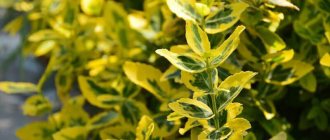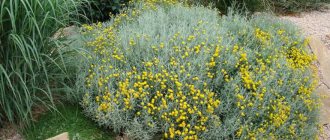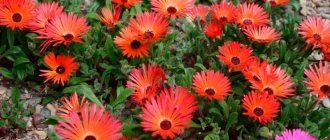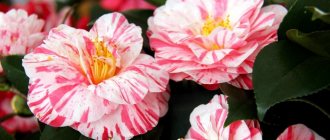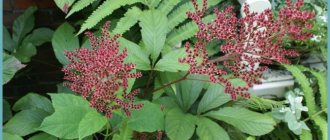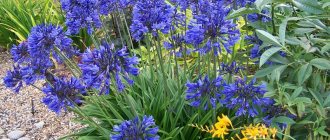Japanese euonymus differs from other types of euonymus in its miniature size and brightly variegated leaves throughout the year that do not fall off. It is a combination of two shades - rich emerald and bright lemon. The pattern can be different: circles, spots, stripes, veins, strokes, etc. In autumn, the color scheme remains the same, which is especially valuable for flower beds of continuous flowering. Today, the plant is gaining popularity in landscape design - its scope of application is actively expanding.
Origin and appearance of the plant
Plants of the Euonymus family are distributed unevenly around the globe. There are various types of plants of this family: creeping euonymus, creeping euonymus, Sakhalin euonymus, European euonymus, gold euonymus and many others. Euonymus has different varieties, but only one of them can grow successfully both in open ground and as a potted crop: Japanese.
What is Japanese euonymus?
The name of the plant is telling; it indicates the country of origin. Japan is famous for its art of bonsai. It successfully uses euonymus, since its luxurious crown with pointed dense leaves lends itself well to cutting and crown shaping. This was quickly appreciated by designers from different countries, and Japanese euonymus became widespread throughout the world. Western landscape designers have also successfully used the Japanese perennial, whose Latin name is Euonymus japonicus.
Euonymus is a shrub with pointed, dark green leaves. The halo of the leaves has a lighter green tint, which makes its color even more attractive for decoration. The evergreen perennial blooms in July with yellow-green umbrella-shaped inflorescences and bears fruit in the first two months of autumn. The flowers of the plant consist of 4 or 5 sepals, petals and stamens in equal numbers.
Euonymus flower
For your information! The description of Japanese euonymus differs in sources from different countries, since the color of its leaves varies from pale green to red. Perhaps it depends on the growing conditions.
The maximum height of the shrub under natural conditions is 7 m. When growing variegated euonymus indoors, its height is unlikely to exceed 1-1.5 m. It is useful for its ability to purify the air from pathogenic bacteria, but is very poisonous when eaten, for which it is called like a sacred euonymus.
Important! Direct contact with leaves and flowers of plants should be avoided. When watering and caring for, you should use gloves or wash your hands thoroughly after handling the plant.
Diseases
In general, the plant is disease resistant. But due to improper care, the following problems are possible:
- The ends of the leaves dry out and curl due to too much light. This also makes their color fade.
- The leaves partially or completely fall off if the plant overwinters in a hot room with low humidity.
- Growth slows down, lower leaves fly off due to overwatering.
The plant can be attacked by scale insects, whiteflies, aphids, spider mites, and mealybugs. To get rid of uninvited guests, you should treat the bush with a special chemical.
Planting in open ground
Creeping euonymus - planting, care and growing in the garden
To grow a beautiful euonymus bush, planting and care must be competent and with knowledge of the characteristics of the plant.
What is needed for planting
If you plan to plant euonymus in open ground, then it is worth determining the time and place of planting. The best period for good adaptation and active growth is early spring.
It is worth preparing in advance material for drainage, fertilizer, lime (when planting in acidic soils). It is also better to dig a hole for planting in advance, about two weeks before planting the seedlings in the ground.
Soil preparation
Choosing the optimal location
Japanese euonymus (variegated) is an unpretentious plant that grows well in both sun and shade. But since this is a tropical species, it will grow more actively and have intense leaf color in partial shade.
Note! In such conditions, watering will be moderate and the leaves will be denser.
When choosing a site for planting, it is necessary to pay attention to the quality of the soil; good water permeability and air permeability, low acidity and high fertility are required. The plant is accustomed to such characteristics in its natural habitat, where euonymus has been growing for a long time. If the type of soil on your garden plot is not suitable, then when planting in a hole or trench you need to add compost, drainage material and slaked lime to reduce the acidity of the soil. You should continue to care for and monitor the acidity of the soil in future years.
Important! Due to the growth of branches, close planting with other trees or near buildings should be avoided.
Step-by-step process for planting euonymus
Step-by-step instructions on how to plant a shrub:
Step No. 1. Preparing the pit.
A hole for seedlings is dug 14-15 days before planting. Its size should exceed the volume of the root system of the planting material by 1.5-2 times. Fill the bottom of the pit with drainage material (gravel, crushed stone).
Step No. 2. Preparing the soil for filling the hole.
It is necessary to mix the soil with fertilizer and, if necessary, lime (150 g for each hole). Part of the soil should be poured into an even layer onto the drainage.
Step No. 3. Planting a seedling.
Planting material is lowered into the hole, straightening the root system. It is necessary to sprinkle the roots of the seedling with the remains of the soil-compost mixture.
Planting euonymus
Step No. 4. Watering.
Immediately after planting, the plant requires abundant watering. You need to repeat it daily for 7-8 days.
Note! When planting Japanese euonymus in boxes and flowerpots, it can be used for landscaping of an estate and as a houseplant.
Why doesn't euonymus turn red?
Evergreens should not turn red. But deciduous species are often grown just to admire the riot of colors for 1-2 weeks at the end of the season. Maybe not for long, but the garden is being transformed. Every day the color of the plants gradually changes until it becomes rich purple, pink, and red.
But some gardeners complain that autumn has come, and deciduous species have turned brown. This can happen for the following reasons:
- Bad light. In order for the leaves to become brightly colored, the plants must receive enough sunlight.
- Excess fertilizer. The euonymus is “fed up” and is not going to change the color of the leaves, they will simply dry out and fall off.
So, in order for the leaves to acquire a bright color in the fall, the plant needs sunlight and poor soil.
Reproduction
Agapanthus: planting and care in open ground
Plants of the Euonymus family can be propagated in two ways: seeds and cuttings.
Propagation by cuttings
Japanese indoor euonymus reproduces well using this method. Cuttings are cut off at the root part in the summer, in June-July. The size of the cutting should be up to 5 cm and have at least one internode that will give rise to shoot growth.
To propagate small-leaved euonymus, the cuttings are planted in soil, which is a mixture of humus and sand in a ratio of 3:1, and sprinkled with sand (a layer of about 5 cm). As soon as the cuttings produce their first shoots (no earlier than 2 months), the root system will be sufficiently formed for transplantation into open ground.
However, autumn time in the Moscow region is not the best time for transplanting into open ground. This should be taken into account when choosing a place to plant cuttings for further growth. In this case, it is better to choose pots in which the plant will safely overwinter indoors.
Growing from seeds
After collecting and drying, plant seeds are stored in a cool place at a temperature of 2-3 °C. In such conditions they begin to hatch. After cracking the protective peel, it is completely removed, and the seeds are treated with a weak solution of magnesium permanganate.
Euonymus seeds
Containers or pots are filled with soil (a mixture of compost with loose, slightly alkaline soil) and the seeds are sown to a depth of 17-20 mm. Moistened crops are covered with film. Shoots will appear in 2-3 weeks.
For your information! In temperate latitudes with a milder climate, planting seeds in open ground is practiced. They need to be planted in the autumn. To preserve the crops, they are covered with straw. The seed preparation process is similar to that described above.
Transfer
This plant needs to be replanted once every 2-3 years. In this case, the pot is taken not much larger than the previous one. The best soil is a mixture of turf, humus and leaf soil in a ratio of 2:1:1. To deoxidize the soil, you can add crushed chalk (5 g per 10 kg).
To make the transplant less painful, the roots are not completely cleared of soil, but the entire lump is transferred into a new container and, adding fresh substrate to the side and on top, lightly compact it. Spray, water the flower and place it in its usual place.
Plant care
The euonymus shrub requires care, like any ornamental plant. It is based on watering and fertilizing plants. Both components may differ in different conditions. This will depend on weather conditions and soil characteristics in the place where the euonymus grows.
Watering mode
Thuja - planting and care in open ground in spring
A tropical plant requires intensive watering, but at the same time, waterlogging of the soil is unacceptable. Therefore, it is worth paying attention to the degree of illumination of the site, air temperature and soil permeability. Under optimal conditions, it is enough to water the plant once every two days during the flowering period, and daily during the period of active growth. A slight drying of the soil is welcome during the period of seed formation. This is ordinary watering in a temperate climate zone.
Important! When it gets cold (temperatures below 15 °C), it is worth reducing watering or abandoning it altogether.
If soil permeability is low, it is necessary to alternate root watering with foliar spraying. In the second case, you should use settled warm water, since cold water negatively affects the growth of the plant and the appearance of the leaves.
Top dressing
For the active growth of rapid euonymus, it is worth paying attention to feeding the plant. It is worth fertilizing the post on which it grows twice a year: in the spring during the period of active growth and during the flowering period, in June-July.
The composition of the fertilizer mixture includes a solution of manure and water in a ratio of 1:10. The solution is used as root feeding. During the flowering period, you can replace the compost solution with potassium and phosphate fertilizers. This will increase the size of the euonymus fruit, then the flowers will be larger, presenting a bright mix of autumn colors on dark green bushes.
Description
This is a beautiful plant with pointed dark green leaves with a lighter edge. The whole plant seems to be striving upward, its side branches extend from the trunk at a slight angle, and the dense foliage emphasizes its vertical direction. The leaves are large, dense, leathery, uneven at the edges.
In terms of growth, this is a very interesting plant. If the conditions necessary for full development are not created, then the increase in growth will only occur in early spring. The rest of the time the euonymus will simply freeze.
Over the course of a year, the euonymus adds 15-20 cm.
If the conditions for this plant are as comfortable as possible, then its growth occurs rhythmically: a period of activity will be replaced by a period of rest.
Japanese euonymus (Euonymus japonica) is an evergreen shrub that blooms in mid-summer. Its flowers are collected in an umbrella of 15-30 pieces and have a very interesting coloring, in which yellow and green shades predominate.
This plant under natural conditions can grow up to 7 m tall.
It tolerates shade well and is resistant to air pollution. The fruiting period begins in September and lasts until mid-autumn.
What ornamental shrubs for the garden are suitable for our climate?
Read here how to avoid making mistakes when planting tree hydrangea.
Japanese euonymus in the Urals: planting and care
Japanese euonymus is a heat-loving shrub, so it can hardly withstand the harsh Ural frosts. At the end of September - beginning of October, it is worth taking care of its insulation. It is necessary to knock down the frame for the cover with polyethylene. After snow falls in the area where the tropical bush grows, it is worth making a large snowdrift. But even this does not always save shrubs from harsh frosty winters.
Note! Watering euonymus in the Urals requires moderate watering, and in the fall it is better to abandon it altogether, replacing it with irrigating the bushes with warm water. If frost hits the plant with moist soil, the roots will quickly freeze and die.
Treatment of diseases
Those who have been breeding euonymus for a long time and with passion are advised to carry out preventive measures to prevent the occurrence of diseases in these unusual plants. Problems are usually caused by excessive watering. Diseases affecting shrubs:
- Powdery mildew. It appears as a whitish coating located on the above-ground wall of the pot. Fitosporin-M will help get rid of the problem. But first, all parts of the bush are wiped and damaged ones are removed. If the container is completely covered with plaque, it must be thrown away.
- Rot of shoots. Under the influence of this fungal disease, the branches soften. It is necessary to promptly remove damaged shoots and treat the bush with Fungicide. If the plant is completely affected, it should be destroyed so that healthy bushes are not endangered.
- Root rot. Symptoms of this problem include limp, dry leaves and soft stems. To solve the problem, the soil is completely changed, and the affected parts of the roots are removed. To avoid infection, during transplantation the container and soil are treated with crushed coal.
Japanese euonymus in Siberia: planting and care
The Siberian region has a climate no less harsh than the Urals, to which the tropical bush is not accustomed. Therefore, in this region, as a rule, it is planted in pots and boxes to decorate the garden and, with the onset of cold weather, put it in the house or on the veranda, where the temperature allows the euonymus to survive.
For your information! At a temperature of −10 °C, the bush freezes in growth, but continues to remain viable and, with the onset of warmth, resumes its development.
Varieties
Today, through the efforts of breeders, more than two dozen varieties have been grown. Plants of different colors of foliage, flowers, different crown shapes and growth vigor.
Popular varieties with a brief description:
- Microphylla aureovariegatus (small-leaved) - foliage is green in the center and light yellow along the edges;
- Mediolicta - plates of a golden hue and a bright green stripe along the edge;
- Albomarginata - with a thin white border on the leaf;
- Albomarginata latifolius - with a wide white edge;
- Aureomarginata - along the edge of the green, round plate there is a light yellow stripe;
- Luna - olive foliage with pale yellow splashes, light green border;
- Ecstasy is a bright lemon yellow, elongated plate with a figured dark green edging;
- Aurea - on the leaf in the center there is a bright yellow wide stripe bordered with green;
- Aurea ovatus - dwarf, small-leaved. The center of the leaf plate is emerald in color, along the edge there is a bright yellow color;
- Marik - oval-elongated leaf, with a dark green center and a yellow border;
- Bravo - the plate is spotted, there are inclusions of irregular shape on a dark green background. Spot color: beige, pale yellow, silver or white.
Preparing for winter
The climate of the temperate zone allows the euonymus to withstand frosts down to −20 ° C, but provided that it is insulated with snow and polyethylene. If frosts in winter exceed −30 °C, then you should not risk the southern bush. It is necessary to transplant the shrub with an earthen lump into a box and bring it into the home for wintering, which may not be heated. The main thing is that the plant does not remain unprotected in the cold.
Note! Snow, straw, spruce branches, dry grass and other materials that create an air cushion can serve as ground cover material for preserving the root system.
Thus, Japanese euonymus is a wonderful plant that amazes with its unusual greenery. It will look impressive on any site. The main thing is to plant it correctly and provide decent care.
